Learn how to plant, grow, and care for the eye-catching Desert Rose (Adenium Obesum) houseplant with this step-by-step guide from planting to blooming.
The Desert Rose (Adenium obesum) is a striking plant that has become popular among houseplant enthusiasts. Its swollen caudex (bottle-shaped trunk), spiraling stems, and bright flowers make it an eye-catching addition to any home. Although native to the deserts of Arabia and Africa, the desert rose can be grown indoors almost anywhere when given the right care.
How to Plant, Grow and Care for Desert Rose (Adenium Obesum)

If you’d like to add this unusual plant to your houseplant collection, this guide will walk you through everything you need to know – from planting and soil needs to ideal growing conditions and routine care. With a little know-how, you can enjoy the desert rose’s delicate blooms and sculptural shape for years to come.
What is a Desert Rose Plant?
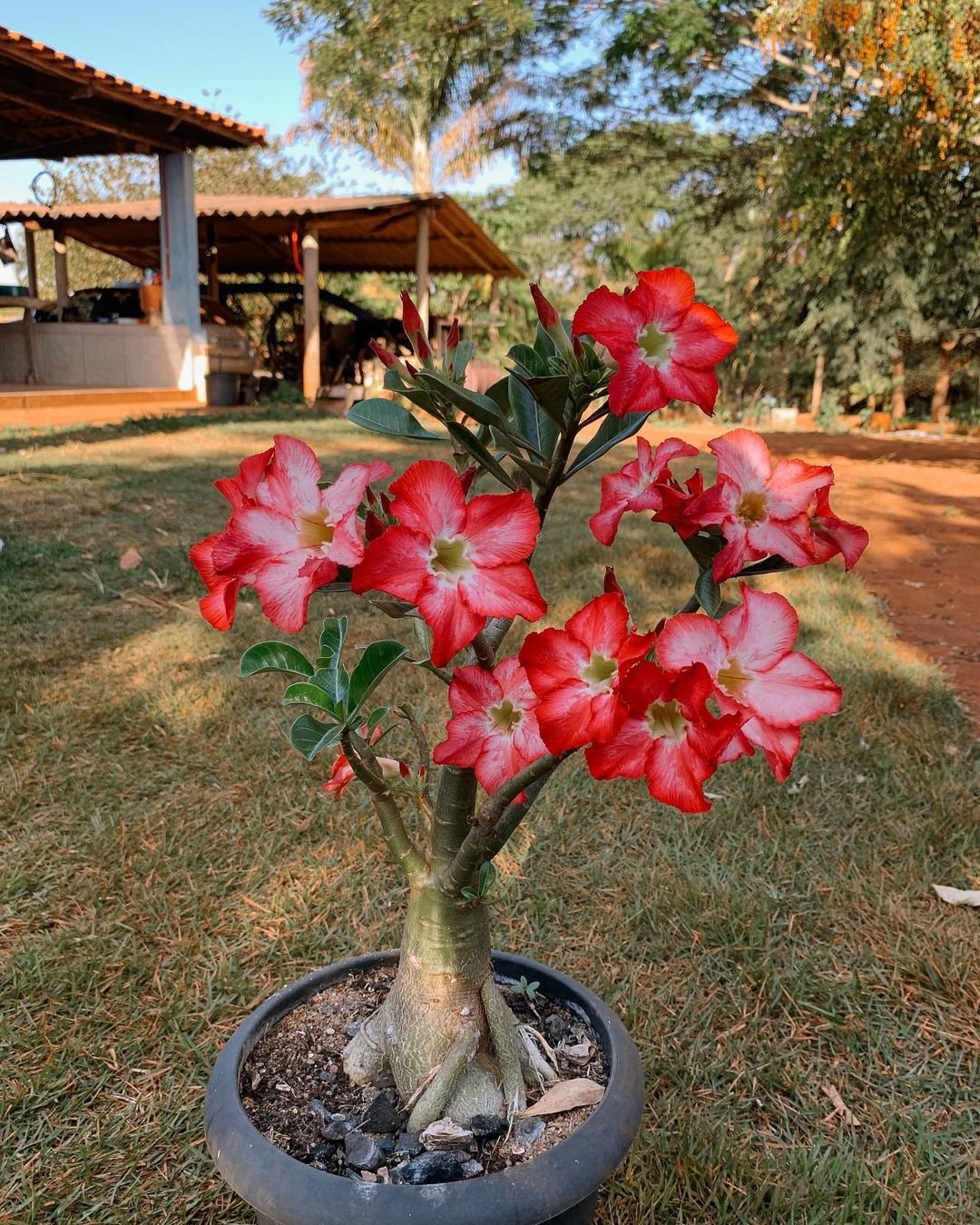
Here’s a short information chart about the Desert Rose plant:
| Attribute | Information |
|---|---|
| Botanical Name | Adenium obesum |
| Plant Type | Succulent/Shrub |
| Soil Type | Well-draining, sandy soil |
| Color Varieties | Typically pink or red flowers, occasionally white or yellow |
| Zones | USDA zones 10-12 (can be grown indoors in cooler climates) |
| Exposure | Full sun |
| Bloom Time | Throughout the year, but particularly in spring and summer |
| Height/Spread | Typically 3-6 feet tall with a spread of 2-3 feet; can vary depending on variety and growing conditions |
The desert rose goes by many names including impala lily, mock azalea, and Adenium obesum (its scientific name). It is a succulent shrub that belongs to the Apocynaceae or dogbane family, which also includes oleanders.
In its natural habitat of the Arabian deserts and parts of Africa, the desert rose developed its distinctively swollen trunk (or caudex) to store water during periods of drought. This allows the plant to survive stretched of extreme heat and dryness between rare rainfall events.
When grown as a houseplant, the desert rose remains a compact plant, typically reaching around 3 feet tall and 1-2 feet wide at maturity. Its stem starts off smooth and green, developing a thick, wrinkled appearance and grayish bark as it ages.
One of the biggest attractions of the desert rose are its vibrant blooms. The 2-4 inch funnel-shaped flowers appear in shades of red, pink, white, yellow, or bi-colors and have a light fragrance. Flowering occurs in spring and summer when the plant is actively growing.
Why Grow a Desert Rose?

There are many reasons why houseplant lovers get hooked on growing desert roses:
- Unique, sculptures shape with a swollen caudex
- Striking spiral stems
- Brilliantly colored, fragrant flowers
- Widely available and affordable
- Relatively low-maintenance once established
- Long-lived perennial plant
Although considered a shrub in its native environment, the desert rose makes an excellent, easy-care potted plant for indoors. With their slow growth, desert roses can be kept fairly compact for years when grown in containers.
How to Plant Desert Rose Seeds
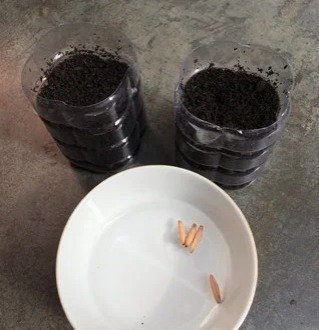
The most affordable and widely available way to grow desert rose is from seed. You can purchase adenium seeds from many online retailers or harvest your own from an existing plant.
Supplies Needed
- Adenium obesum seeds
- Well-draining potting mix
- Seedling trays or small pots
- Bottom heat mat (optional)
Instructions
- Use a well-draining seed starting mix or make your own by combining 1 part potting soil with 1 part perlite or coarse sand.
- Fill seedling trays or small pots with the seed starting mix and gently press down to slightly compact it.
- Push the adenium seeds into the soil so just the tops are exposed. Space them about 1-2 inches apart.
- Water the seed tray/pots thoroughly to settle the soil around the seeds.
- (Optional) Use a seed heat mat set to around 75-85°F to encourage faster germination.
- Place the planted seeds in a warm spot with plenty of bright, indirect light. Keep the soil lightly moist but not soggy.
- Adenium obesum seeds may take 2-6 weeks to sprout at optimal temperatures of 75-90°F. Lower temps will delay germination further.
- Once the seeds have sprouted, move them into bright, direct light to prevent etiolation (stretching and weakness).
- When the seedlings develop their second set of true leaves, transplant them into their own small pots filled with well-draining cactus/succulent potting mix.
How to Plant a Desert Rose from Cutting
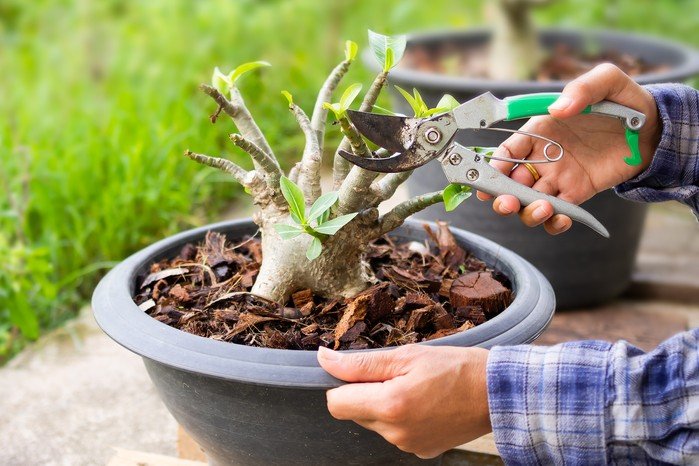
Propagating desert roses from cuttings is another easy method that may allow you to grow an exact clone of a plant you admire. Here’s how:
Supplies Needed
- Sharp, sterilized pruning shears
- Well-draining potting mix
- Rooting hormone powder (optional)
- Small pots
Instructions
- Take 4-6 inch long stem cuttings from a mature, healthy desert rose plant. Cut just below a leaf node.
- (Optional) Dip the cut end into a rooting hormone powder to encourage faster root development.
- Fill small pots with well-draining potting mix suitable for cactus/succulents.
- Use a pencil or stick to make a hole in the potting mix and insert the cutting, ensuring at least two leaf nodes are buried in the soil.
- Water the potting mix thoroughly and place the planted cuttings in a warm, bright spot out of direct sun.
- Keep the soil consistently moist but not soggy until roots develop, which can take 4-8 weeks.
- Once rooted, allow the top inch of soil to dry out between waterings and gradually introduce more light.
Desert Rose Growing Conditions
Whether starting with seeds, cuttings, or an established plant, adeniums need very specific conditions to thrive indoors. Provide the following:
Sunlight Needs

Desert roses absolutely need as much direct sunlight as possible to grow their best. Outdoors, they prefer full sun. Indoors, place them in a south or west-facing window. Supplement with a grow light if you don’t get enough natural sun.
Temperature
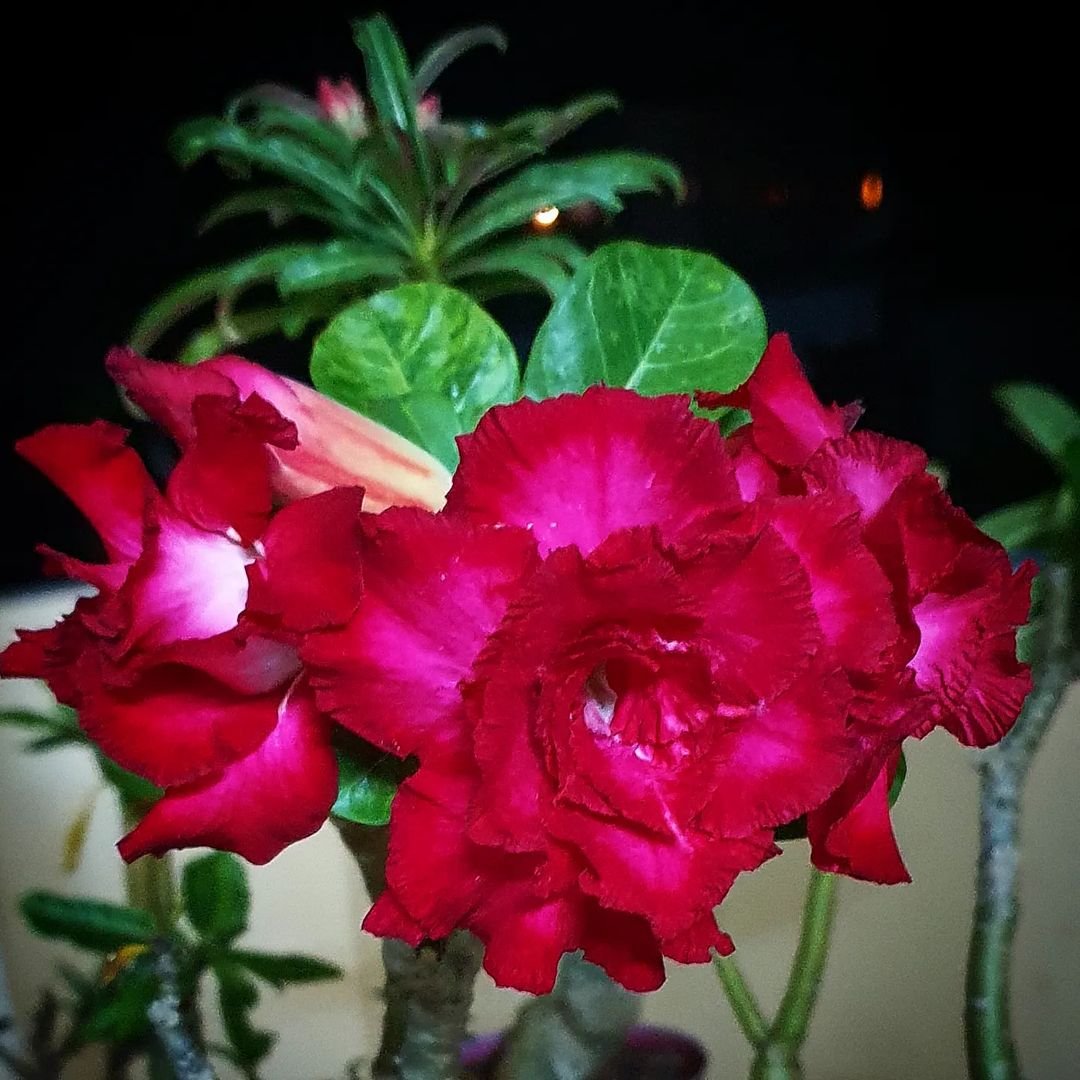
This desert plant loves heat. Provide temperatures between 70-90°F during spring and summer when it is actively growing. Cooler temperatures of 50-70°F are best in fall and winter to allow it to go semi-dormant.
Watering
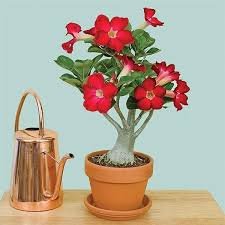
During the spring and summer growth period, allow the potting mix to dry out about halfway down before watering deeply. In fall and winter, cut back on watering significantly, only providing enough to keep the caudex from shriveling. Adeniums won’t tolerate soggy soil.
Humidity
Like other succulents, desert roses can handle very low humidity levels found in most homes. However, higher humidity of 40-50% will encourage better growth.
Soil
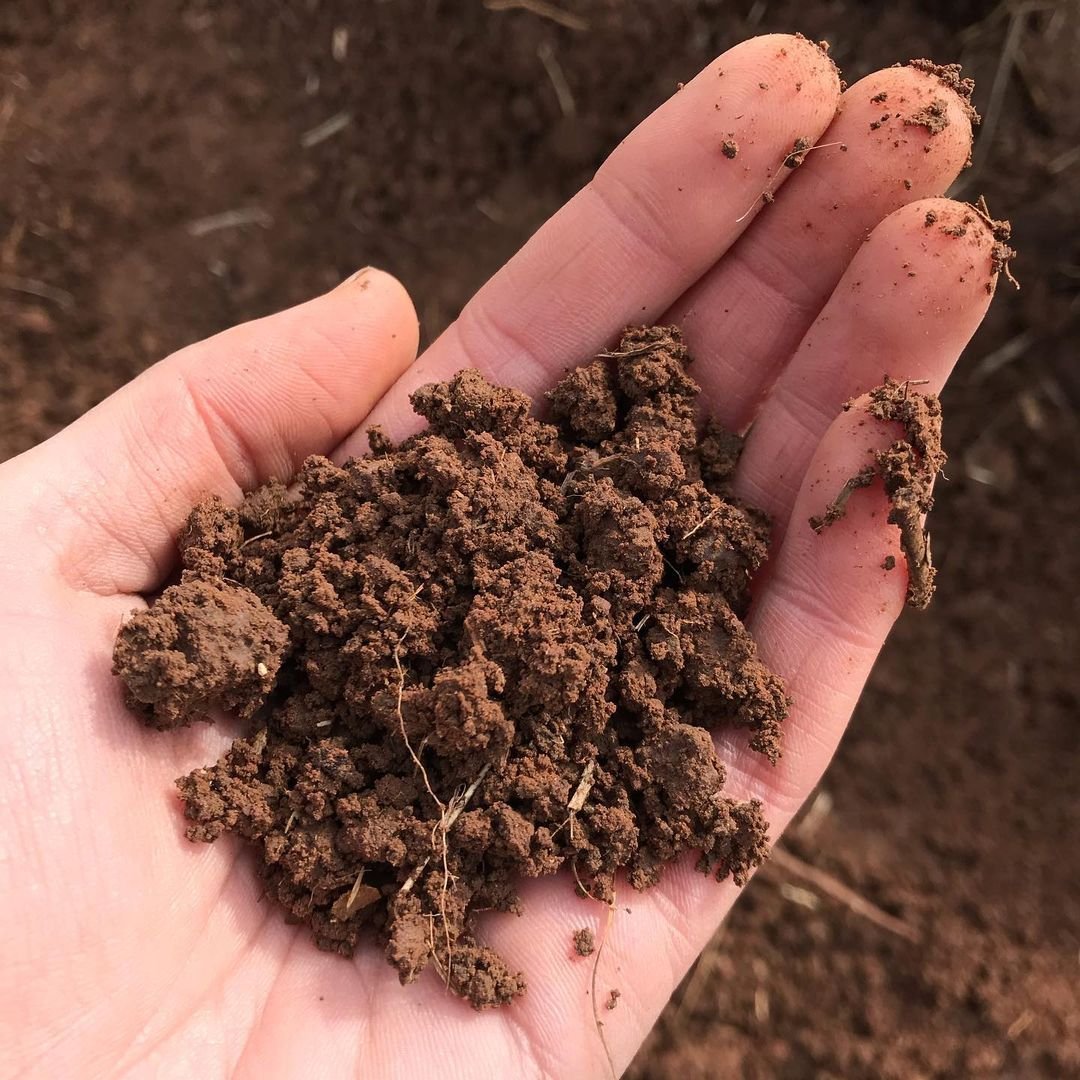
Adeniums need a very well-draining potting mix similar to what’s used for cactus and other succulents. Look for pre-made cactus/succulent mixes or use a combination of potting soil amended with plenty of perlite, pumice, or coarse sand.
Fertilizing

Feed monthly in spring and summer with a balanced liquid fertilizer diluted to half strength. You can also use a slow-release fertilizer formulated for cactus plants. Avoid fertilizing in fall and winter.
Pruning
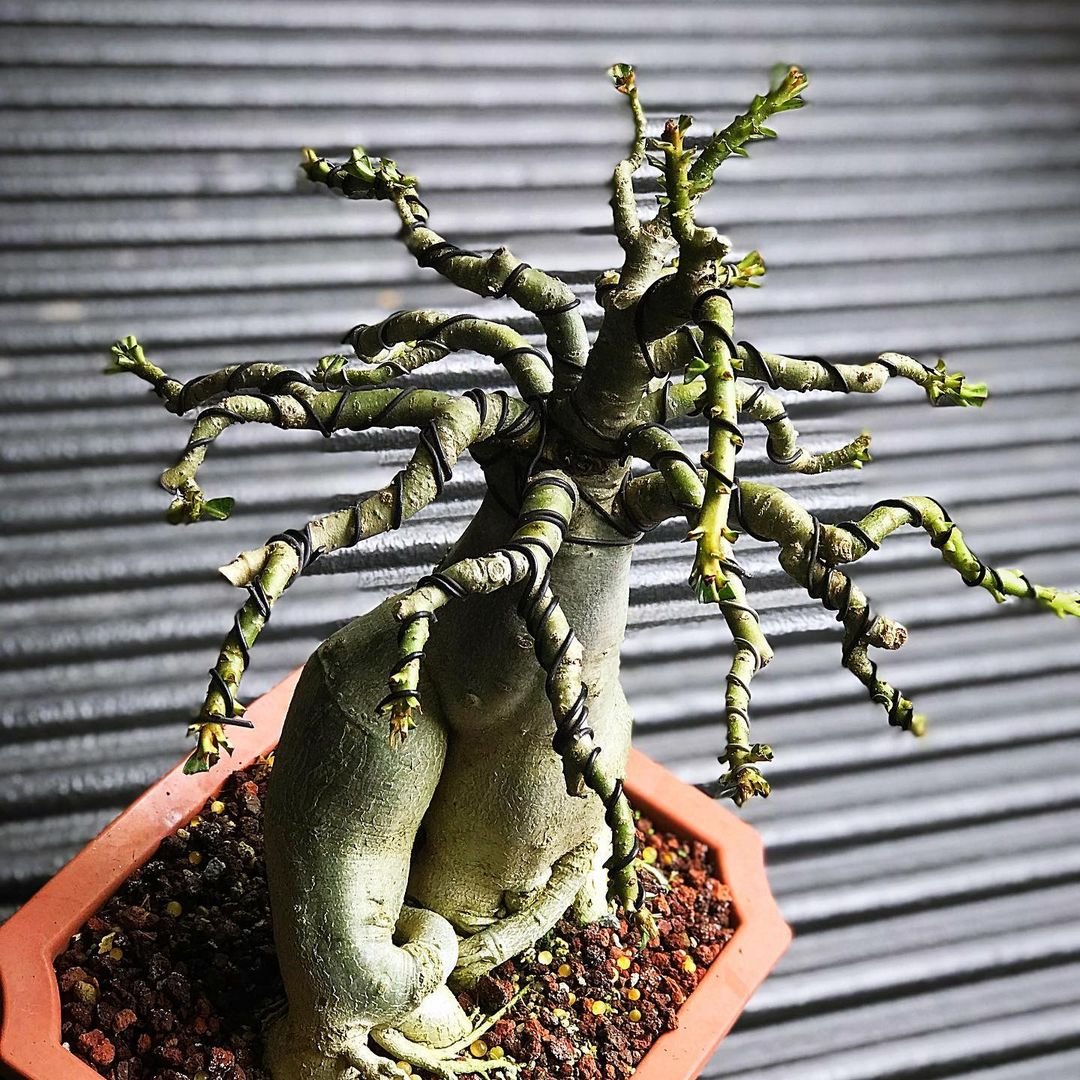
Prune off dead or damaged stems anytime. You can also prune your desert rose in spring to shape it or control its size if needed. Just be sure to disinfect pruning shears before and after use.
Repotting
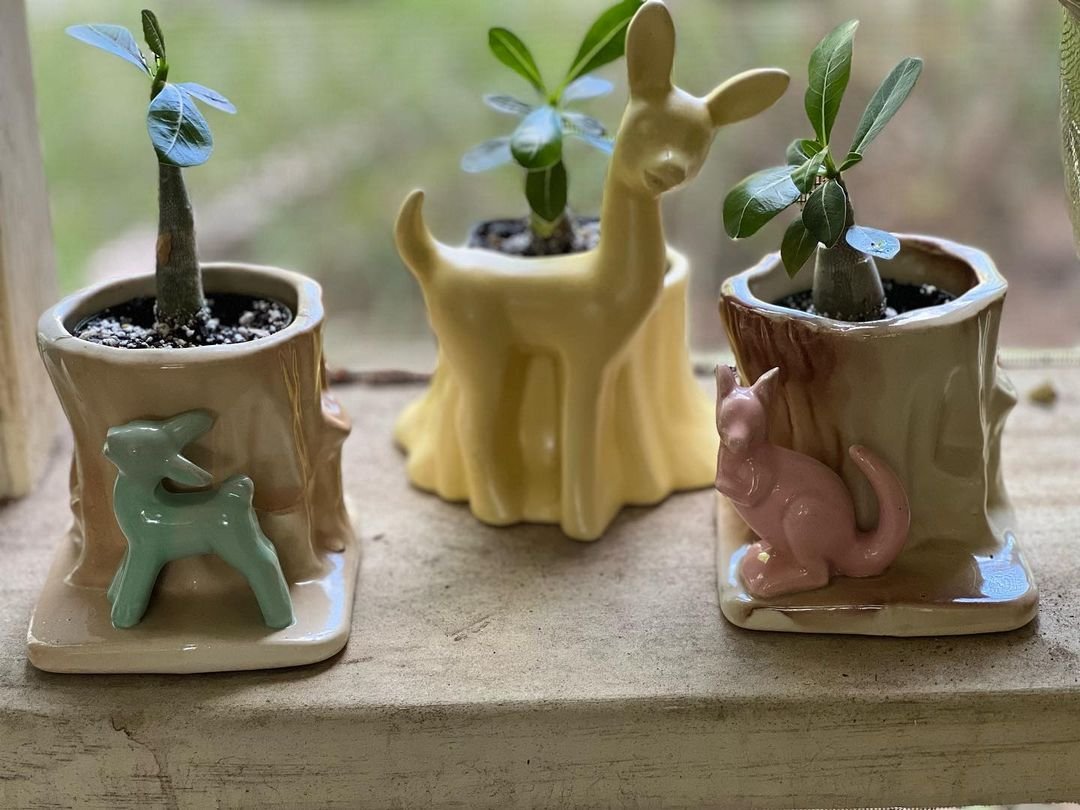
These slow-growing plants don’t require frequent repotting. Only move them into a slightly larger container when they’ve become potbound, waiting until spring to do so.
Desert Rose Flowers

One of the biggest draws of growing adenium plants are their beautiful flowers. Here are some tips for getting your desert rose to bloom:
Flowering Season Desert roses typically bloom in late spring through early fall when the plant is actively growing and temps are warmer. Most only flower once per year with a concentrated bloom period of 4-6 weeks.
Bloom Requirements To initiate flowering, your adenium needs:
- Bright, direct sunlight (minimum of 6 hours per day)
- Warm temperatures of 70-90°F
- Well-draining soil
- Proper watering (not too much or too little)
- Maturity (most don’t bloom until 2-3 years old)
Encouraging More Flowers To get your desert rose to produce more flowers each season, give it a light pruning in early spring before new growth emerges. Removing a few inches from each stem will encourage more branching and flower clusters.
You can also provide a balanced fertilizer with trace minerals like zinc and iron during the months leading up to the bloom period.
Desert Rose Flower Colors

One of the most appealing aspects of adenium flowers are their vibrant colors.
You’ll find selections that bloom in shades of:
- Red/crimson
- Pink
- White
- Yellow
- Multi-color (striped or contrasting centers)
Many cultivars also have unique flower forms like doubled petals. This makes it easy to find one that suits your preferences if growing from seed.
Caring for Desert Rose Plants Year-Round

Successful desert rose care involves providing the right conditions through each season. Here are some tips:
Spring & Summer These are the active growing months for adenium obesum. Provide:
- Maximum sunlight and warmth (70-95°F)
- Regular watering when top 2″ of soil is dry
- Monthly feedings with a balanced fertilizer
- Extra humidity if possible (set on pebble tray or use humidifier)
Fall & Winter During this rest period, cut back on:
- Sun exposure
- Watering (only when soil is completely dry)
- Temperature (provide 50-70°F)
- Stop fertilizing
By providing a cooler, drier rest period, your desert rose will be better able to rebloom the following season.
Common Desert Rose Problems
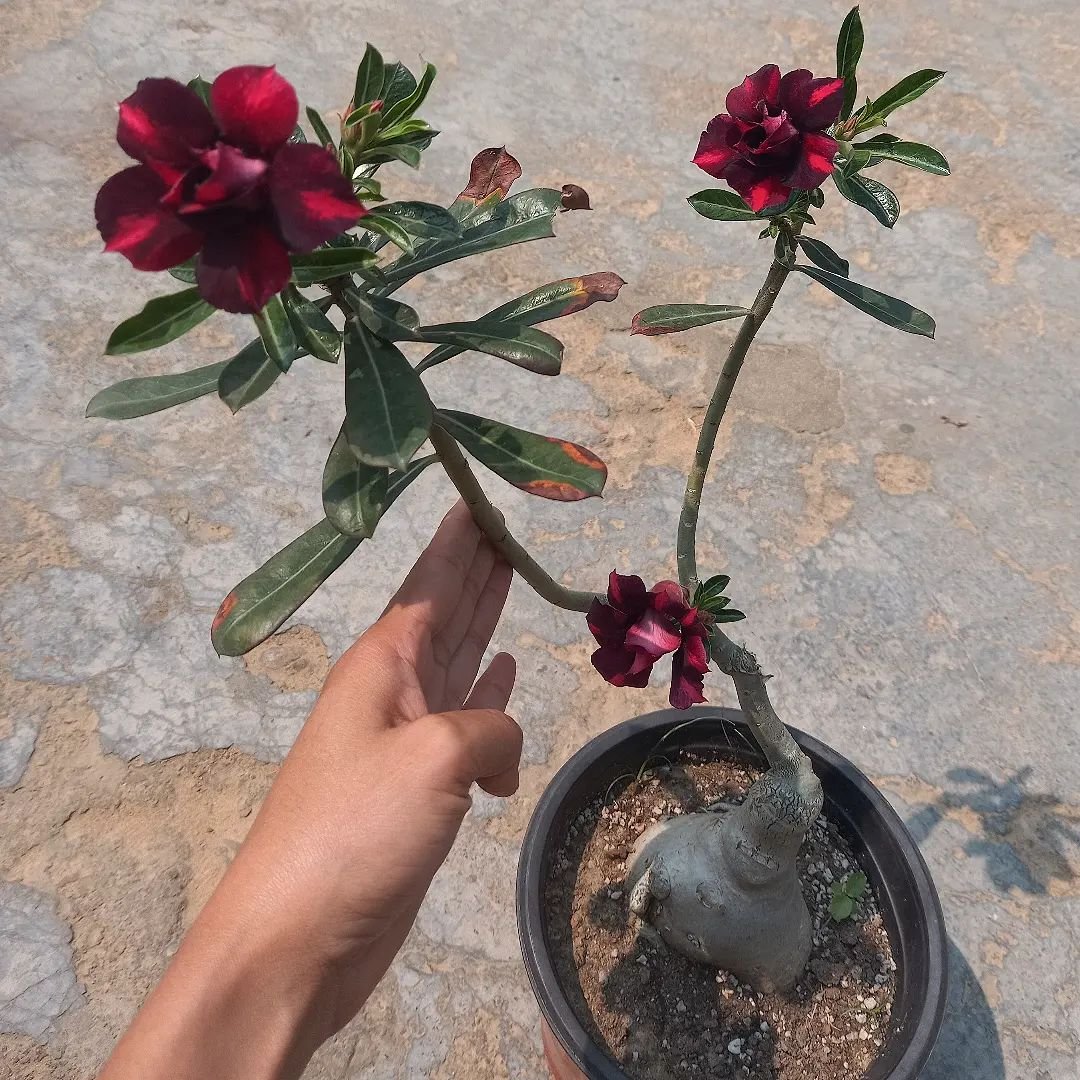
Although fairly resilient plants once established, there are a few common issues to watch for:
Shriveled Caudex If the desert rose’s swollen trunk starts to wrinkle and shrivel, it needs more water. Provide a deep soaking and increase humidity around the plant.
- Leaves Dropping: Too little water can also cause the leaves to droop and drop off prematurely. Increase watering frequency during the growing season.
- Leggy Growth: Stretching and elongated stems is a sign your adenium isn’t getting enough sunlight. Move it to a brighter window or add a grow light.
- No Blooms: Lack of flowers is usually due to insufficient sunlight, cool temps, improper watering or an immature plant. Check your growing conditions.
- Pest Issues: Mealybugs, spider mites and fungus gnats can occasionally be a problem. Use insecticidal soap, neem oil or other natural pest remedies.
With the right care and environmental conditions, desert roses can thrive for years as beautiful, easy-care houseplants. Provide plenty of sun, warmth and excellent drainage and you’ll be rewarded with an eye-catching display! Let me know if you have any other questions.
Pingback: Guide to Growing the Beautiful Crown of Thorns Plant -
Pingback: Growing and Caring for the Beautiful Desert Ros...
Pingback: 30 Gorgeous Spring Flowers to Brighten Your Garden -
Pingback: The Ultimate Guide to Watering Outdoor Potted Plants Perfectly -
Pingback: 35 Awesome Flowers : that start with A - Gardener's School